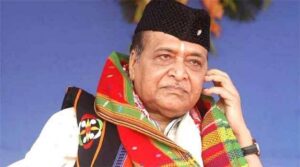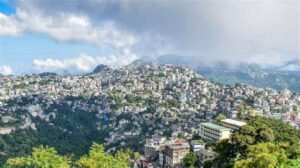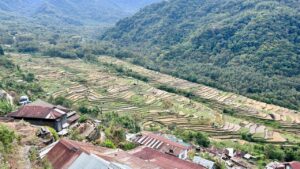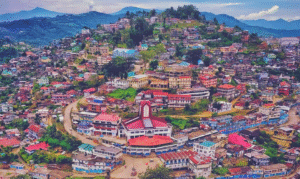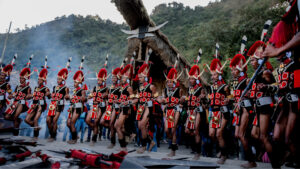Kangla Fort is one of the most important cultural and historical landmarks in Northeast India. Located in Imphal, the capital city of Manipur, it has witnessed centuries of royal rule, warfare, religious practices, and traditional lifestyles. This ancient site is more than just a monument—it represents the soul and strength of the Meitei people.
For generations, Kangla Fort stood as the center of power and spirituality. It remains a symbol of identity, resilience, and pride for Manipuris. Understanding Kangla Fort is essential to understanding Manipur’s roots and its connection to the larger Northeast Indian region.
Historical Roots – The Cradle of Meitei Civilization
The history of Kangla Fort goes back more than 2,000 years. It was the capital of the Meitei kingdom from ancient times until the British defeated Manipur in 1891. The term Kangla means “dry land” in old Meitei, and it was the seat of power for Meitei rulers since the time of King Pakhangba, believed to have ruled in the first century CE.
Over centuries, Kangla served as the political, cultural, and military headquarters of the region. It saw the rise and fall of kings, foreign invasions, and resistance. After the Anglo-Manipur War, the British took control of the fort, and later it was occupied by the Indian Army until it was returned to the people of Manipur in 2004. Today, Kangla stands as a protected heritage site and a reminder of the region’s storied past.
Language and Communication – Voices from the Past
The fort is closely tied to the evolution of the Meiteilon language, also known as Manipuri. This is the official language of Manipur and widely spoken across the state. Ancient royal decrees and records were written in Meitei Mayek, the traditional script of the Meiteis.
Within Kangla, communication was both formal and sacred. Royal proclamations were announced here. Priests and scholars used oral and written traditions to pass down history, mythology, and laws. The site is a storehouse of linguistic heritage.
Festivals and Celebrations – A Sacred Stage
Kangla Fort was once the center of major religious and cultural festivals. One of the most important festivals is Lai Haraoba, a celebration of the gods and the creation of life. Rituals were often conducted inside the fort by Maibis (priestesses), who performed ancient dances and songs.
Festivals like Cheiraoba (Meitei New Year) and seasonal ceremonies also had connections to Kangla. In earlier times, royal blessings were given here during festivals, and traditional dances and martial arts were performed in its courtyards.
Arts, Crafts, and Music – The Cultural Pulse
The royal court at Kangla encouraged the growth of traditional Manipuri arts. Dance forms like Ras Leela, inspired by Hindu mythology, were performed during temple ceremonies. The fort was also a place for music, with instruments like the pena played during important events.
Craftsmanship flourished around Kangla. Artisans made pottery, wove silk textiles, and carved sacred figures. These crafts were not just decorative but carried deep cultural meaning. The artistry from this era continues to influence Manipuri culture today.
Cuisine and Culinary Traditions – Flavors of the Kingdom
While no cooking happens in the fort today, the food culture of Kangla’s royal past is still alive. The kitchens of Kangla would prepare dishes using local herbs, vegetables, and fermented ingredients. Popular items like Eromba (spicy mashed vegetables and fish), Chamthong (vegetable stew), and Ngari (fermented fish) were common.
Food was also part of rituals and offerings. During festivals and religious ceremonies held in Kangla, food was offered to gods and spirits. These traditional recipes are still loved and cooked in Meitei households across Manipur.
Attire and Ornamentation – The Regal Look
People in the Kangla era wore beautiful and meaningful clothes. Kings wore the traditional pheijom (wraparound cloth), while queens and noblewomen wore phanek and innaphi—a wrap skirt and shawl, often made of hand-woven silk or cotton.
Jewelry was important. Gold and silver ornaments, like bangles, earrings, and khadang-phanek (anklets), were worn during festivals and official gatherings. Each piece of clothing and jewelry reflected a person’s role, age, and respect in society.
Beliefs and Values – The Spirit of Kangla
Kangla Fort is deeply spiritual. It is the sacred home of Lord Pakhangba, a divine serpent-dragon in Meitei mythology. The Meitei people followed Sanamahism, an indigenous religion that focused on nature, ancestors, and household gods.
Inside Kangla, there were temples, sacred trees, and altars. Religious values such as respect for elders, harmony with nature, and community service were taught and practiced here. Even today, these values are a strong part of Manipuri identity.
Customs and Etiquette – Royal Protocols and Rituals
In ancient times, entering Kangla required special permission. Visitors had to follow royal customs, such as removing footwear, bowing to the king, and showing respect to spiritual sites. Silence was often observed in sacred zones.
Even today, when people visit Kangla, many maintain these customs. Rituals and reenactments held at the fort follow age-old practices that show how etiquette was woven into daily life.
Architecture and Symbols – Stones That Speak
Kangla Fort showcases the brilliance of Meitei architecture. The most iconic symbols are the Kangla Sha, two dragon-lion statues at the entrance. These represent strength and protection.The fort had moats, brick walls, temples, and administrative buildings. Though many structures were damaged or destroyed during wars, restoration efforts have brought some of them back. The architecture reflects both practicality and spiritual symbolism.
Oral Traditions and Storytelling – Keeping the Past Alive
Much of Kangla’s rich history is passed down through oral storytelling. Elders tell tales of heroic kings, wise queens, and spiritual events. Ballads, poems, and folk songs bring these stories to life.These stories are not just entertainment—they are educational. They teach young people about their culture, history, and values. Kangla is central to many of these narratives.
Interactions with Nature – A Harmony with the Earth
Kangla was designed to live in balance with nature. The fort is located near the Imphal River, and its original design included sacred groves, water ponds, and gardens. Trees were planted for rituals, shade, and meditation.This connection with nature continues today. The restored fort now includes green zones, traditional flora, and eco-awareness efforts. Nature and spirituality remain deeply linked in the site’s design and daily use.
Challenges and Preservation – The Road Ahead
For many years, Kangla Fort was not accessible to the public. Wars and military occupation led to neglect and damage. Since being handed back to the state government, efforts have been made to restore it. However, there are still challenges. Pollution, urban pressure, and climate change threaten the site. Preservation requires careful planning, funding, and community involvement. Kangla is not just a structure—it is a living legacy that must be protected.
Contributions to Society – A Beacon of Heritage
Kangla Fort plays an important role in education, identity, and cultural awareness. It hosts school tours, cultural programs, exhibitions, and heritage walks. Artists, historians, and researchers use it as a learning resource. It also inspires pride and unity among Manipuris. As a symbol of resistance and resilience, Kangla teaches lessons of strength and self-determination.
Connection to Northeast India – A Shared Identity
Kangla is not just important to Manipur. It holds meaning for the entire Northeast region. Many cultural traits, such as respect for nature, oral storytelling, and craftsmanship, are shared across the region.As a cultural hub, Kangla connects tribes, languages, and histories. It reminds us of the rich diversity and unity of Northeast India.
Summary – More Than a Monument
Kangla Fort is a symbol of Manipur’s soul. It stands as a silent witness to ancient glory, cultural richness, and modern challenges. It tells stories through its ruins, rituals, and symbols.From language and festivals to architecture and values—Kangla offers a full picture of Meitei heritage. It is a cultural classroom, a sacred space, and a reminder of the region’s past.
